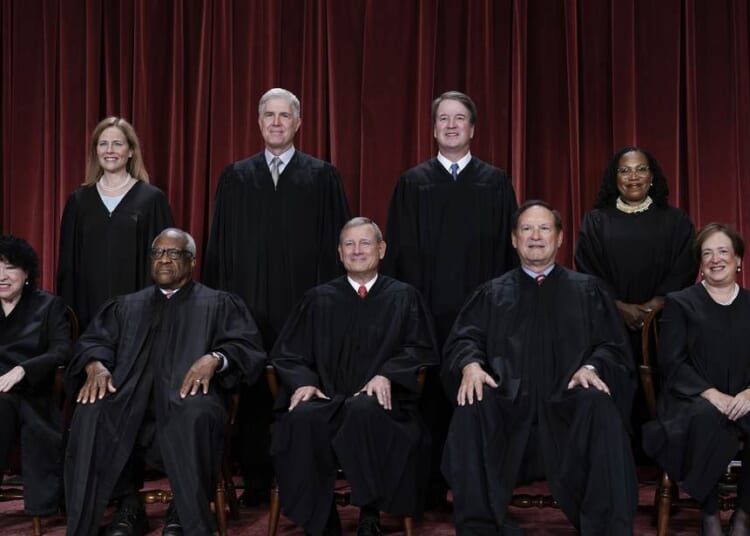Just as Joe Biden wants to save democracy by banning his political opponents from running for office and putting them in jail, liberal lawyers are now arguing that the only way to save the Supreme Court is to unpack it by appointing six or more liberal justices.
To somebody untrained in the arcane doublespeak of critical theory, packing the court with new liberal justices might sound like, well, packing the court.
But if you are a critical theorist, you begin with the presumption that legitimacy is not based on on rules and norms that assure people that the system isn’t rigged, but rather that legitimacy is based on rigging the system so that Leftists always win.
And when liberals lose, the system must be changed to ensure they do.
How to Fix the Supreme Court: The time has come to connect popular anger over the conservative supermajority with concrete ideas for reform in the Washington @monthly by @RMPWolfe https://t.co/hsEEKrqaux
— Washington Monthly (@monthly) January 8, 2024
The Supreme Court is broken, argues The Washington Montly’s Rob Wolfe, following the legal theories that now permeate the Left. The court has been making decisions that offend the Left, and that is because Republicans have been appointing the Justices. The only way to remedy the problem is to expand the court by appointing new, Leftist justices, restoring the proper balance.
This wouldn’t remove the conservative justice–a possibility that exists through the impeachment process–but rather render them irrelevant.
This is democracy, which The Washington Monthly is determined to save.

Let’s examine the basic argument:
Anyone concerned about the Supreme Court today should be working to prise that window open further. And to do so, they ought to draw on the robust and inventive debate that is brewing among scholars in law schools, think tanks, and advocacy organizations over how to fix the Court. Some of their ideas are bold structural changes: dividing the Court into rotating panels, stripping it of jurisdiction over certain issues, or controlling its certification process. Others are practical and based on policies already proven to work elsewhere, such as creating a “Congressional Review Act” for Supreme Court decisions, as already exists for executive branch regulations. What these ideas share is a recognition that the rights-giving 20th-century Court that liberals came to respect, even revere, is gone. Today’s progressives now realize that the high court is not an infallible fount of wisdom, and that it is historically more often a conservative force; and with that understanding comes a question that these scholars will help us all to answer: What is the Supreme Court even for?
President Joe Biden and other Democratic leaders have not embraced this deeper reform debate, perhaps recognizing that the political moment hasn’t yet arrived. When the survival of democracy depends on each coming election, a little short-term thinking is understandable.
But one day that moment will come, and it may come suddenly: a wave election, a string of Senate vacancies, a scandal of new, earth-shattering magnitude, or a series of decisions as harmful as Dobbs. When that happens, reformers need to have a plan ready to go—a plan that will require broad public consensus about what problems need to be solved (Should we be restoring the Court’s legitimacy? Limiting its power? Or some combination of both?) and a detailed road map to achieve those goals through nitty-gritty policy. And it’s not as simple as drafting up a document and leaving it on the shelf. Being ready means spending years on movement building to bring together academics, policy wonks, and regular Americans, all waiting to grasp that perhaps fleeting and unforeseeable opportunity. Either that, or submit to being governed for another 30, 40, or 50 years by unelected partisans in robes.
You may have noticed that this process of delegitimizing the current court has already begun, with unrelenting attacks on conservative justices–attacks so outrageous that the liberal justices have been pushing back, defending the integrity of their colleagues.
The point is to lay the groundwork for a bold plan to completely remake the court in the Left’s image.
The Supreme Court needs to be thought of as a neutral arbiter for political disputes, not just another player in them, the law professors argued—and so fixing it today is a question of restoring that aura of public trust. Right away, that goal disqualified the most talked-about idea at the time: court packing. Supporters of court packing like the political scientist Aaron Belkin argue that the Supreme Court has already been stacked with highly ideological conservatives who gained their seats through norm-breaking political brinksmanship, and so to add, say, six liberal or moderate justices would actually be to unpack it. But as Epps and Sitaraman pointed out, that reasoning would mean little to Republicans, who would have every incentive to repack the Court as soon as they regained power. (Belkin, for one, finds that argument unconvincing. “The first thing is that the Court has already been stolen. If your wallet is stolen, you don’t forgo efforts to recover it just because it might be stolen again,” he told The Atlantic in 2020.)
Nothing says opposition to norm-breaking political brinksmanship like completely upending the rules for how the Supreme Court is constituted to ram through progressive-backed “reforms.”
There are progressives who want to just neuter the courts and not completely upend it. And there are others who simply want to do away with the Court as a check on unconstitutional legislation. Why even pretend that the Constitution matters?
Epps and Sitaraman’s institutionalist, fix-it attitude defines one side of a central divide in the reform debate. You might call their approach the “legitimacy” school of reform, the one that holds that we need to restore respect and trust in the Court. The other side—call it the “democratic” or “disempowering” school—emerged in a lengthy, at times fiery reply to Epps and Sitaraman in the California Law Review. The authors, Harvard’s Ryan Doerfler and Yale’s Samuel Moyn, offered a much simpler plan for the Court: Get it out of the way. “Asking ‘how to save the Supreme Court’ is asking the wrong question,” they wrote. “Saving the Supreme Court is not a desirable goal; getting it out of the way of progressive reform is.”
If you took seriously the Left’s criticism of Netanyahu’s Supreme Court reforms in Israel as being honest, get over your belief that Leftists use language and arguments as ways to determine what is true or false, good or bad. They already know what is good and simply use language to manipulate you by using your values and allegiance to honesty against you.
In reality, they just want to win, as they say, “by any means necessary.”
The only response to a Court that has grabbed too much power, they said, is to take some of it away. One way to do that would be to strip it of jurisdiction over subject areas in which it might feel tempted to interfere with progressive change, such as environmental regulation or health care reform. The Constitution gives the Supreme Court “original jurisdiction” over disputes between the states and between high-ranking ministers such as ambassadors. That can’t be taken away. Everything else falls under appellate jurisdiction, which Congress has the constitutional power to regulate. Doerfler and Moyn didn’t outline a definite plan for how jurisdiction stripping should take place; the point, they said, is for the people themselves to decide how the country should be run, and to clear a path through obstructive courts to put those values into action. Other “disempowering” tools can be part of that conversation: “override” provisions that would allow Congress to vote to nullify Supreme Court decisions, or “poison pills” that would trigger more drastic policies if the Court overturned legislation (though Doerfler and Moyn are skeptical about the power of this deterrent).
I will admit that the Supreme Court is hardly a perfect institution, in the same way that no human institution can ever be. One of the key reasons conservative organizations like the Federalist Society exist is a recognition by conservatives that the Court had abandoned the principle that the Constitution means what it says and had gone on a progressive legislation-creating spree.
But unlike the current Left-wing approach, they did it by using the established norms, making their case to the public and politicians, who in turn actually ran for office telling the public their aims when appointing justices. The people actually DID get to decide–Trump even listed the candidates for the Court he would consider while running for office.
Liberals want to short-circuit all that and get straight to the point, which is to silence conservatives, sideline the constitution, and simply impose their vision.
And then call it “saving democracy.”
“I want to suggest that courts are the enemy, and always have been,” Josh Chafetz, a Georgetown Law professor of the “disempowering” school, said on an afternoon panel with Doerfler, Sitaraman, and another Georgetown scholar, Victoria Nourse. In one exchange, Chafetz called for retaliation against the justices as individuals, wondering aloud whether Congress should consider withdrawing funding for law clerks or even “cutting off the Supreme Court’s air conditioning budget.” The quip drew a faint chuckle from the crowd, but Doerfler, deadly serious, interjected: “It should not be a laugh line. This is a political contest, these are the tools of retaliation available, and they should be completely normalized.” What put us here, he said, is the idea that the Court is an “untouchable entity and you’re on the road to authoritarianism if you stand up against it.”
You may have noticed that Chuck Schumer tried this approach when he–after a Leftist tried to assassinate a conservative Supreme Court Justice–suggested that the Court’s budget be reduced by (not coincidentally) the same amount of money as the Court’s security budget.
Schumer in 2020, at a pro-abortion rally:”You have released the whirlwind and you will pay the price! You won’t know what hit you”
Two years later, when the Dobbs decision leaked, a man attempted to assassinate Kavanaugh in hopes of stopping the rulingpic.twitter.com/hKTto5Yr74
— John Hasson (@SonofHas) December 31, 2023
As Rob Wolfe himself writes, Leftists haven’t yet decided how to defang the court–pack it, threaten it, or make it irrelevant–but they are all agreed that the Supreme Court is no longer an ally as in the past, so it must be “reformed” to ensure that Leftism wins. If the Constitution is a barrier, it must be changed through some version of critical theory.
Critical theory asserts that language is nothing but another way to seize power–whether it is using “democracy” as a synonym for tyranny or redefining the plain language of the Constitution.
This is summarized perfectly by the redefinition of “truth,” which has become “my truth.”
The progressives’ “truth” is that they need the power to restructure society to reflect their whims. If that requires destroying the Court, jailing political opponents, opening the borders and calling them “secure,” or insisting that Biden is more hale and hearty than a 30-year-old, they do so without a second thought. Even the most basic terms, such as “man” and “woman,” no longer have any inherent meaning.
“My truth.”
Leftism is not a political theory to be argued for but a revolutionary political theory that demands action ASAP.
If that means blowing up our Republic, that is what they will do. That is what they are doing right now, before our eyes.

